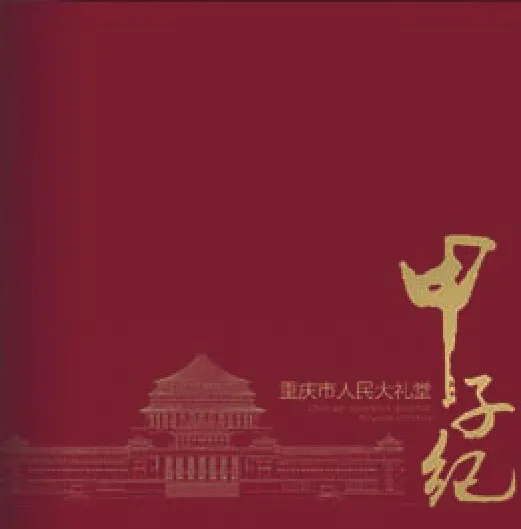如果没有那个傍晚的偶遇大礼堂的传奇或许将与我们无缘
2017-09-28◇文|田东
◇文|田 东
如果没有那个傍晚的偶遇大礼堂的传奇或许将与我们无缘
◇文|田 东



1951年7月的一天傍晚,时任西南军政委员会办公厅副主任段云,出现在重庆市马鞍山对面的一个建筑工地上,这是正在兴建中的重庆市委机关办公地。一个三十多岁的工程师,正一面翻着图纸,一面向身边的几个同事指点设计和施工。工程师的热情,感染到了原本有些闷闷不乐的段云,上前和对方攀谈起来。
这位听力很差的工程师告诉段云,自己有一个设计方案,是为前阵子一个在征集设计方案的礼堂画的,结果没被看上。言谈中不乏遗憾和牢骚。哪知这一下引起了段云的兴趣,他告诉这位工程师,晚上把设计图纸带来瞧瞧。
段云为什么会对这个方案感兴趣?
One evening in July, 1951, Duan Yun, Associate Director of the General Office of Southwest Military and Political Committee, appeared at the construction site for the workplace of the Municipal Party Committee of Chongqing, opposite Ma’an Mountain. He was a little upset until so affected by an enthusiastic engineer in his thirties who was leafing through the drawings and directing his colleagues there, that he went to talk with him.
The engineer with bad hearing told Duan Yun gloomily that he had a design proposal for an auditorium, but it was turned down. Surprisingly, Duan Yun showed interest in and asked to have a look at it.
Why was that?
此时的段云,除了西南军政委员会办公厅副主任的职务,还有一个身份:拟建设的西南军政委员会大礼堂设计方案征集工作负责人。遇到这个工程师前约10多天,刚刚初选了方案,可结果让段云很沮丧——没有一个看得上眼的。
晚上,这位工程师和他的夫人,带着一幅1.63米高、3.91米长的巨幅彩绘图来到段云面前。画卷徐徐展开,段云愣住了。细细端详一阵后,他大声说着“好图啊,好方案,难得的好方案”。
随后,段云将此方案向西南军政委员会副主任贺龙等作了汇报。当晚,邓小平、贺龙等就接见了这个年轻人。
再接下来的一切顺理成章。三年多后的一九五四年,一座气势恢宏的建筑耸立在马鞍山上,这就是如今重庆市民熟悉的重庆市人民大礼堂。那位听力很不好的工程师,名叫张家德。
At that time, Duan Yun was not only the Associate Director of the General Office of Southwest Military and Political Committee, but also in charge of collecting the design proposals for the proposed auditorium of the Southwest Military and Political Committee. About 10 days earlier, before he met the engineer, he was very disappointed, for none of the designs was satisfying.
It was when the engineer and his wife showed a huge colored drawing with 1.63 meters high and 3.91 meters long in front of him that he was astonished. Looking at it closely for a while, Duan Yun said excitedly, “Excellent! It’s so incredible.”
Later, Duan Yun reported this proposal to He Long, another associate directors of Southwest Military and Political Committee. On the same night, Deng Xiaoping and He Long received this young man.
Three years later, in 1954, a grand building towered on Ma’an Mountain, which is exactly the household name, People’s Great Hall of Chongqing. And the engineer is Zhang Jiade.
如今,这个故事出现在重庆大学出版社的《重庆市人民大礼堂甲子纪》一书中。我一直认为,在书中关于大礼堂60多年风风雨雨的众多故事中,这个故事是最神奇的。就像悉尼歌剧院的设计方案是从字纸篓里捡出来的一样,重庆市人民大礼堂这座中国现代难得的优秀建筑,在最初的设计阶段,险些与我们擦肩而过。
让段云有些疑惑的是,这么好的方案,在之前的方案展示遴选中,自己怎么没有印象呢?其实,张家德也参加了6月的那次方案评选,且方案一挂上墙就引来了围观者的惊叹。可当时的初评者认为,这样一个方案美则美矣,却不现实,依照当时的建筑技术,单是那座大跨度的礼堂屋顶,就无法实现。于是,在段云等人来审看方案前,工作人员就把张家德的方案给撤下了。
60多年后的今天,当我们回过头去看,段云那次傍晚到马鞍山的散步,就仿佛带上点命中注定的味道了。无法想象,如果没有那次偶遇,没有段云的敬业和敏感,我们还有没有机会看到这座美丽的建筑。就像某些人和事,看似不可阻挡,事成必然,其实大风起于青萍之末,有时候一个不经意的决定,一次纯属偶然的外出,就已经改变了那风的方向和强度。
恰如《重庆市人民大礼堂甲子纪》前言所述,本书从大礼堂的诞生过程、艺术价值、技术成就、历史记忆和文化内涵以及建成后的历次维护与建设逐一回顾,全景式地向我们展示了这座建成后就被誉为“亚洲第一大建筑”的宏伟建筑。一段段饱含沧桑的历史,将引领你走进大礼堂的丰富的物质和精神世界。一张张精美的图片,一篇篇珍贵的文字和数据就如一朵朵美丽的浪花。
随意撷取几朵,先睹为快吧。
This story now has been recorded on the book Sixty Years History of the People’s Great Hall of Chongqing, published by Chongqing University Press. I always regard it is the most miraculous one among the plenty stories on the trials and hardships of the Great Hall. Because, similar to the tale that the designing of Sydney Opera House was picked from a wastebasket, we barely missed the People’s Great Hall of Chongqing, an outstanding Chinese modern architecture.
Duan Yun was puzzled why this wonderful proposal left little impression on him at begnning. It turned out Zhang Jiade's proposal was part of the selection held in June, which was astonishing to the onlookers. However, judges did not think his design was practical according to the techniques at that time. For example, the wide span of the roof could not even be realized. That is why his proposal was removed before Duan could see it.
In retrospection, it is more of a destiny that over 60 years ago Duan Yun walked on Ma’an Mountain at that dusk. Unimaginably,without this unexpectedencounter and Duan Yun’s devotion and sensitivity, we might have no chance to see this beautiful architecture. It proves that although someone or something seems irresistible and inevitable, changes still happen.
Just as the Preface of Sixty Years History of the People’s Great Hall of Chongqing stated, this book successively reviews the emergence, artistic values, technical achievements, historical memories, and cultural connotations of the Great Hall and its maintenance and construction after completion so as to show us a panoramic view of this grand architecture which was honored as “the First Architecture in Asia”.
Let’s pick up some optionally and feel the beauty.
比如大礼堂的缘起。的确如“传说”中说的那样,1950年,刘伯承、邓小平、贺龙等就筹划修建一座可供当时的西南行署四省一市各族各界人士举行“共商国是”的大型会议、可供群众观看文艺演出的大礼堂。邓小平还特别强调,古代皇帝的宫殿讲究“非令壮丽无意重威”,这座新中国的人民的大礼堂,一定要雄伟壮观以“重”人民当家作主之“威”。
再比如,修大礼堂花了多少钱?那个“无底洞”的传闻,真相又是怎样的?
你可能会惊讶,大礼堂建设之初的拨款是200亿元,最终的费用还不止。可是别急,大礼堂修建时是1951年,那时的200亿元,约合1955年3月后流通的新人民币200万元左右。最终,不含其它固定资产购置费用,大礼堂建筑开支437万余元,平均每平方米175元。
这个数字不仅在如今看来价廉物美千值万值,就是和当时的国内同期同类工程比,也低了35%以上。
其实,大礼堂在建设之初就十分注意节约。因为经费问题,大礼堂原本规划的升降舞台被取消。设计师张家德修改了外部设计方案,力求在获得原有设计效果的同时节省费用。一些材料的使用也是各出奇招,比如大礼堂屋面的琉璃瓦,由外购改为在江津珞璜烧制,围绕大礼堂一圈的望柱栏杆,原本该用汉白玉,后来采用栏杆本体用混凝土浇筑,表面用从各处搜集的碎盘碎碗,研磨成粉,加上白瓷粉、白水泥调制后涂刷,干后的质感,与汉白玉也差不多。
大礼堂的名字也是一波三折。1953年2月10日,建设之中的建筑工人合影照片上,印的是“西南军政委员会大会堂”字样,三个月后的再次合影,题字已经变成了“西南行政委员会大会堂”。落成之初,大礼堂牌楼上是贺龙手书的“西南行政委员会大礼堂”,可很快,随着西南大区的撤销,重庆划归四川管辖,那行题字变成了现在大家熟悉的“重庆市人民大礼堂”。
For instance, the reason for constructing the Great Hall is truly the same as it was stated in the “legend”. In 1950, Liu Bocheng, Deng Xiaoping and He Long etc. were planning to build an auditorium to hold large conferences and to offer theatrical performances. Deng Xiaoping also stressed that the great hall in new China must be grand and magnificent to show the stateliness of people as the masters of their own affairs.
In addition, how much did the construction cost? What is the truth of the hearsay about “the bottomless pit that can never be filled”?
You might be surprised that the allocated fund for the Great Hall at the beginning was 20 billion Yuan, and the real cost was far beyond this. But remember that it was built in 1951 when 20 billion Yuan equaled 2 million new RMB in March, 1955. Finally, excluding other purchase expenses on fixed assets, the constructional expenses was about 4.37 million Yuan, 175 Yuan for per square meter.
It does not only seem like a bargain now, but also cost more than 35% lower than other projects of the same time and the same kind in China.
In fact, much attention was paid to economy since its construction. The originally planned elevator-stage in the Great Hall was canceled, and the exterior design was revised. Also the use of some materials is full of tricks. The handrails and the backbones for the handrails were made of concrete pouring rather than the white marbles.
Even the naming of the Great Hall was full oftwists and turns. On February 10th, 1953, the photos of the workers were printed with “Great Hall of Southwest Military and Political Committee”. However, the words on the photos which were taken three months later were “Great Hall of Southwest Administrative Committee”. At its completion, He Long wrote “Great Hall of Southwest Administrative Committee” on the decorated archway of the Great Hall. Soon after, with the canceling of the southwest district, Chongqing was under the administration of Sichuan, and the inscription was changed into“the People’s Great Hall of Chongqing” which is familiar to many people.
如今,在大礼堂参观的游客,在人民广场健身休闲的市民们,也许不知道,大礼堂也曾经如被岁月摧残的美人憔悴不堪。书里对当时的境况是这样描写的:“20世纪90年代的大礼堂,历经烈日、酸雨、烟熏、潮气、硝蚀、白蚁、风化的摧残,加上十年浩劫期间人为破坏,大礼堂里里外外的损坏相当严重。一圈样式陈旧的围墙,将它与世隔绝。透过镂空的墙缝,可见院内杂树丛生,陋房乱建,牌楼前门禁森严,市民不得擅自入内。而封闭的大院里驻扎了八个单位,分属三个系统。院内的好地盘、实用房均被分割占据,剩下偌大的主楼没人要,长久闲置在那里。大厅里人气稀少,舞台上蛛网密而光线暗,灰尘厚集,落寞破败,主楼一侧的锅炉房终日喷吐黑烟,含二氧化硫的烟尘使昔日美丽的雕梁画栋密布黄斑;鼓风机开动时,整个大厅都发出隆隆的震动声;厅内天花板垮塌,座椅残缺,彩画斑驳,厕所堵塞,电线老化,铝芯裸露,白蚁肆虐,老鼠横行,触目惊心……”
1991年,大礼堂管理处成立,大礼堂迎来了新生。1991年5月20日,大礼堂正式开放供公众参观。当年参观人数达到3万人,超过当时的大足石刻。1997年5月25日,大礼堂撤围墙建广场,对市民全面开放。如今,大礼堂已经是重庆具有代表意义的地标性建筑,著名旅游景点,国家重点文物保护单位。而2006年的那次落架大修,也让大礼堂焕发了青春。
虽然由于城市的发展,重庆鳞次栉比的摩天高楼让我们不能像几十年前那样,站在大礼堂上就能远眺嘉陵江长江两江交汇,但是,站在三峡博物馆平台之上,极目远眺,落日的余晖斜照在礼堂顶端的金色宝顶上,宫殿巍巍,楼台参差,中国传统建筑民族形式的典雅华美之感油然而生,庄严宏大的气势扑面而来。
翻动这部书,目光从书中那些精美的图片上流过的时候,笔者的心情起伏难平。这部书对大礼堂60年的甲子风云做了一个回顾。而13年前的2004年,笔者就和大礼堂进行了一次亲密接触。
也许,因了13年前的这一次机缘,有了下面这些跟亲历关联的文字。
People might not know that the Great Hall once was in a hard time. “In 1990s, the Great Hall suffered multiple damages from sunshine, acid rain, smoke, humidity, nitrate erosion, termites and weathering together with the man-made damages during the Ten Years Catastrophe, so its internal and external damages were quite serious......There were few people in the hall, and the dim stage was covered thick spider webs and dusts. A desolated and dilapidated view haunted over. The boiler house beside the main building spouted out black smokes all day long......The ceiling of the hall collapsed......”
In 1991, the Great Hall embraced its rebirth. On May 20th, it was officially opened to the public, with 30 thousand attendance, more than the visitors to Dazu Stone Carvings. On May 25th, 1997, the surrounding walls were removed, and a square was built. Now, the Great Hall has become a landmark of Chongqing and the National Key Historical Relics Preservation Unit.
Although skyscrapers at present blocked our view from the Great Hall to overlook the junction of Yangtze River and Jialing River, we can still enjoy the sunset glows shedding over the golden dome of it when standing on the platform of the Three Gorges Museum, appreciate the elegance and magnificence of this classic Chinese traditional architecture, and experience the majestic and grand vigor come out ofit.
When looking at the exquisite pictures on this book, I was very excited, for it reminds me of an encounter with the Great Hall 13 years ago.
Consequently, I had another incredible story related to that experience.
13年前4月的一天,在大礼堂采访一个演出时,无意中听管理处办公室的黄敏女士说起,大礼堂马上就要50周年了。这无疑是一个极好的新闻题材。经过一周多的采访,笔者供职的报社推出了三个整版的大礼堂50周岁报道,引起了市民热议。几天后,市文物局原副总工程师,现重庆市历史文化名城专委会秘书长吴涛先生打来电话,称他的父亲也曾经为大礼堂的建造出过力。于是,笔者和同事连夜赶到原重庆建筑大学,找到了吴涛的父亲,著名建筑专家吴惠弼先生。当时吴老已经是耄耋之年,但精神尚好。他语气缓慢但清晰地向我们这些后生小子,回忆起当年张家德带着他的助手登门拜访,求教关于大礼堂穹顶那巨大的钢结构空间网架的技术问题的情景。
按张家德的设计,这个网架的直径要达到46.33米,是半球形无柱空间网架。按最初的计算,需要采用大规格的角钢,可这种钢材短时间内无法从外地购进,而且无法做到与民族形式建筑造型和室内空间的完美结合。
心有不甘的张家德在吴老先生及其他专家的帮助下,在60多年前采用重庆当时的2.5英寸等边小角钢成功铆接。吴老透露,当时在大礼堂施工现场给张家德做助手的黎绍怀和黄智民,就是他的学生。
笔者一边聆听吴老讲述,一边想,那是一个怎样火热的年代,那又是怎样一群火热的人?
如今,大礼堂已入花甲,可依然那么青春逼人。这座礼堂,已经成为了这座城市的一个符号。“我们塑造了建筑,而建筑反过来也影响了我们。”对一座影响我们的建筑,只有了解得更多、更细,我们才能更好地去走近它,和它对话交流。而这本《重庆市人民大礼堂甲子纪》,无疑为我们搭起了一座桥梁。
One day in April, 13 years ago, I heard from Ms. Huang Min, who worked in the Management Department, that the 50th anniversary of the Great Hall was coming. After an interview for more than a week, the newspaper I worked for published three pages to report the anniversary and caused a heated discussion. Several days later, Mr. Wu Tao, the former Vice General-Engineer of Chongqing Bureau of Cultural Relics and the current Secretary-General of the Special Committee of Chongqing Famous Historical and Cultural Cities, told us his father once attributed to the construction of the Great Hall. His father, Mr. Wu Huibi, a famous architecture expert was in his eighties and in good spirits. He recalled the scene when that Zhang Jiade and his assistants visited him for the technical problems concerning the huge steel space truss structure on the dome of the Great Hall.
According to the design of Zhang Jiade, the space truss structure was a hemispheric space truss structure with no column, and its diameter must be 46.33 meters, which means large-sized angle steel must be adopted, but was not available within a short time, and could not ensure a perfect match to the ethical-styled designing.
With the help of Mr. Wu Huibi and other experts, Zhang Jiade had to adopt the 2.5 inches equilateral angle steel and riveted successfully. Mr. Wu Huibi said that Li Shaohuai and Huang Zhimin who were the assistants of Zhang Jiade on the construction site of the Great Hall were his students.
What a fervent time! What a group of enthusiastic people!
Now, the Great Hall, even in its sixties, is still youthful. It has become a symbol of the city. “We mold the architecture, and in turn the it molds us.”We have to see more details, so as to get closer to communicate with it. Undoubtedly, Sixty Years History of the People’s Great Hall of Chongqing is a bridge.

《人情之美》丘彦明 著中信出版社 出版

《亲爱的普鲁斯特今夜将要离开》亨利·拉西莫夫 著陆茉妍 余小山 译四川文艺出版社 出版

《想I:贾樟柯电影手记1996-2008》贾樟柯 著 万佳欢 编台海出版社 出版
丘彦明是上世纪八十年代台湾文学黄金时代的见证人。从1979年到1988年,丘彦明当了近十年的副刊编辑,从《联合报》副刊痖弦的得力助手,到后来接任《联合文学》总编辑。因工作需要,她得以与当时文坛最瞩目的作家频繁接触,梁实秋、张爱玲、白先勇、西西、三毛……这些熟悉的名字都是她的约稿对象。这本《人情之美》即是丘彦明与12位作家的交往与纪念,其中有访问稿、有日记、有信笺,还有追忆,因为有“情”,所以“美”得真切动人。书中亦附有张爱玲、三毛等多位作家写给丘彦明的信件手迹与照片,让人们得以再次重温台湾文学那段蓬勃又美好的时代。
本书讲述了普鲁斯特逝前最后的时光,死亡正步步紧逼,而他作为一名伟大的作家,心心念念的仍旧是他的作品。在他看来,《追忆似水年华》永远不会完结,它是一部在不断发展着的作品,是一条饥渴的幼虫,不断啃食普鲁斯特的血肉与灵魂。但是,于普鲁斯特而言,唯有写完《追忆似水年华》的最后一个字,他才敢放下对这世间的所有羁绊,他才能了无牵挂地死去。此刻,本书打破了传记文体本身的藩篱,作者亨利·拉西莫夫聚焦于普鲁斯特的晚年,用清晰而从容、严肃而诙谐的笔触描绘了伟大的作家如何以写作来反抗死亡,以及如何与即将到来的死亡相处。
本书稿是著名电影导演贾樟柯第一部回顾其电影创作和思路历程的著作,也是他对自己1996年到2008年这十余年来导演生涯的梳理与总结,全景记录了他思考和活动的踪迹。书中收录了贾樟柯导演生涯各时期对电影艺术孜孜不倦的探索和独特的思考,另有多篇与电影界、艺术界、媒体等多领域关键人物的代表性访谈。全书以贾樟柯所拍电影为纲,所有收录文章以发表的时间顺序排列,呈现出导演个人敏感而执着的心路历程,也体现出贾樟柯以电影抒写乡愁的深切情怀。本书是2009年后时隔8年的再版,封面换成了“邮政绿”皮。而今年下半年,2008—2016年的电影新手记《贾想2》也将出版。
编辑/陈科龙
The Very Encounter on That Evening Created the Legend of the Great Hall
Article | Tian Dong
